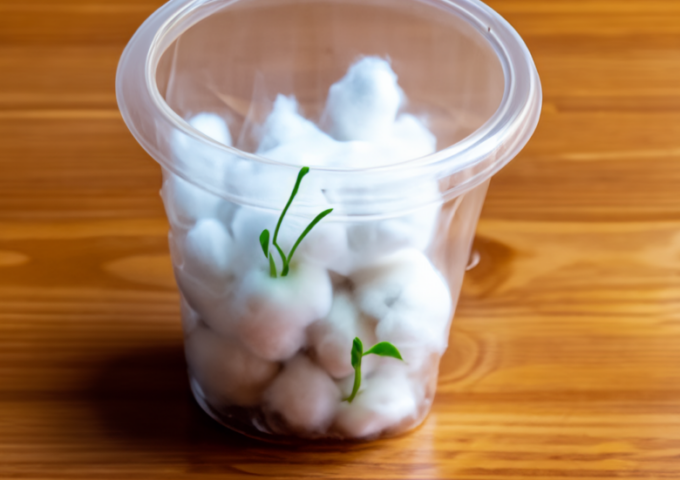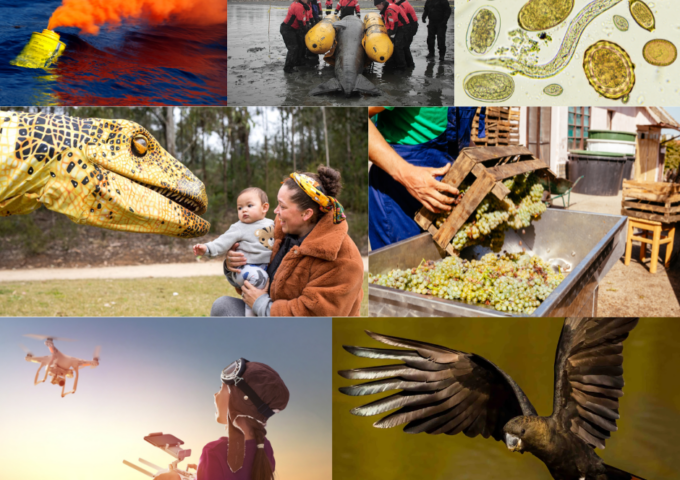
Create your own mini environment and grow some plants. Find out what plants need to survive.
What you’ll need
- 2 clear plastic cups (more if you want to make a few)
- Sticky tape
- Cottonwool
- Alfalfa or rocket seeds
- Water
What to do
- Gather your materials on a flat surface.
- Line the bottom of one plastic cup with cottonwool.
- Sprinkle some water over the cottonwool to make it slightly damp.
- Evenly spread 4 or 5 seeds on the top of the damp cottonwool.
- Put the other plastic cup upside down on top of the first one, to create an enclosed container.
- Seal the cups together with sticky tape to make the container airtight so the cottonwool doesn’t dry out. This your first mini greenhouse!
- Repeat the above steps and make a few mini greenhouses with slight changes so you can compare what happens to the seeds.
- Place the mini greenhouse on a sunny windowsill.
- Check it every day to see what happens to the seeds.
Different ways to experiment
- What happens when you place one in a dark place like a cupboard?
- What happens when you add salty water instead of fresh water to the cottonwool?
- What happens if you don’t add any water at all?
- What if you don’t add any cotton wool?
- Try using different seeds or beans in different cups. What differences can you see?
Try measuring the seedlings with a ruler each day to see which conditions help a plant to grow the best.
After your tests, make some guesses about what things you think plants need to grow.
What’s happening
Your mini greenhouse is self-watering. The water sprinkled on the cottonwool evaporates when the greenhouse gets warmer. Evaporates means that it turns into water vapour. This water vapour rises, and when it reaches the top of the greenhouse it cools and condenses, which means that it turns back into water. When enough water vapour condenses, a drop forms and trickles down onto the cottonwool. This waters the plant.
When the cups were taped together, air was trapped inside. The trapped air has enough carbon dioxide for the seedlings to live for about 1 month. Once the seedlings run out of carbon dioxide, they must be removed from the greenhouse so they can get more carbon dioxide. You can plant them in a pot of soil in a sunny spot. The plant’s leaves will then collect carbon dioxide from the air and its new roots will collect vitamins, minerals and water from the soil.
Another name for a mini greenhouse is terrarium. A terrarium is an indoor enclosure used to grow and observe plants in conditions similar to those in nature. Seeds need the right temperature and amount of water (also written by its chemical formula H2O) and oxygen to sprout. When a seed sprouts, we say it germinates. The seed contains all the energy and food, or nutrients, that the plant needs to germinate. When the seed has used all of its nutrients, the growing plant makes its own nutrients, a type of sugar called glucose (C6H12O6). It does this by using carbon dioxide and water, with the help of energy from sunlight. This process is called photosynthesis.
Photosynthesis is a chemical reaction. It can be shown as an equation:
carbon dioxide + water (with the help of sunlight) → sugar + oxygen
or, using chemical symbols:
6CO2 + 6H2O (+ sunlight) → C6H12O6 + 6O2
(This means ‘6 carbon dioxide molecules plus 6 water molecules turn into 1 glucose molecules and 6 oxygen molecules’.)
This DIY Science activity was adapted from Questacon’s Hands on Activities page. You can find this and more experiments at: https://www.questacon.edu.au/learn-and-play/activities/mini-greenhouse






